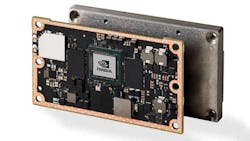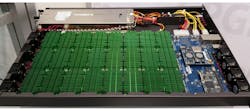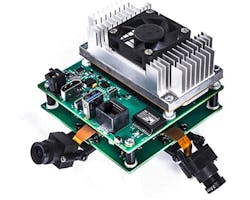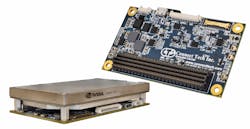The increased interest in deep neural nets (DNNs) and deep learning are driving the popularity of platforms like NVidia’s Jetson TX2 (Fig. 1). The 50-mm by 87-mm Jetson TX2 module has a 256-core NVIDIA Pascal GPU, a pair of 64-bit NVIDIA Denver 2 ARM-compatible cores, and four 64-bit ARM A57 cores. It delivers 2 TFLOPs of single precision performance.
The Jetson TX2 supports NVidia’s CUDA programmer environment as well as the cuDNN (CUDA deep neural network) platform, allowing it to support deep-learning frameworks like Caffe and Tensorflow.
1. NVidia’s Jetson TX2 has a 256-core NVIDIA Pascal GPU that delivers 2 TFLOPs of performance.
The Jetson TX2 requires a carrier board to operate. NVidia’s development kit is good for checking out the module, but less so for deployment. Developers need to create their own carrier board or go with one of the many third-party products like Connect Tech’s Orbitty.
Connect Tech has a number of platforms that support the TX1 and TX2, including the 1U Jetson TX2 Array (Fig. 2) rack server that uses 24 modules. The modules are connected using their 1-Gbit Ethernet connections. These are tied together with an on-board switch that has two 10-Gbit and two 1-Gbit SFP+ ports. There is also an on-board, SMARC-based processor that supports three 2.5-in SATA drives and an out-of-band, 1-Gbit Ethernet port. The system has a pair of redundant power supplies.
2. Connect Tech’s Jetson TX2 Array is a 1U rack server that has 24 modules.
Antmicro’s Deep Learning Kit (Fig. 3) supports NVidia’s Jetson TX1 and TX2. It was running Antmicro’s SegNet sequencing neural network that was trained to navigate a model car through city traffic with a propagation time of only 50 ms. The board supports up to 6 CSI-2 cameras.
3. Antmicro’s Deep Learning Kit supports NVidia’s Jetson TX1 and TX2.
For very small systems, developers can use Connect Tech’s Sprocket (Fig. 4). The Sprocket exposes USB OTG and a 4 lane MIPI CSI-2 interface. It also has two 3.3-V UARTs, two I2Cs, and four GPIO pins. The wireless support is built into the Jetson TX1 and TX2, so that’s also available. It is ideal for SWaP-constrained systems such as drones.
4. Connect Tech’s Sprocket supports the Jetson TX1 and TX2.






